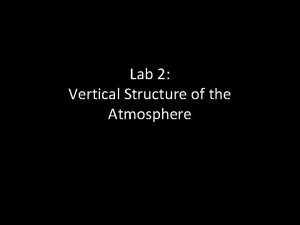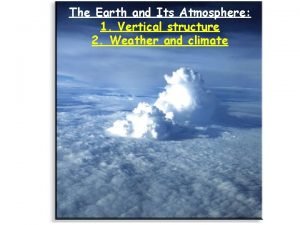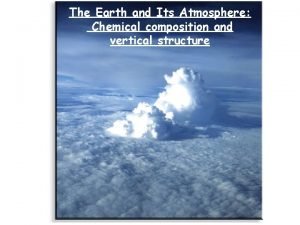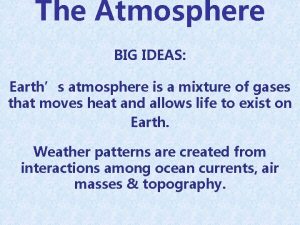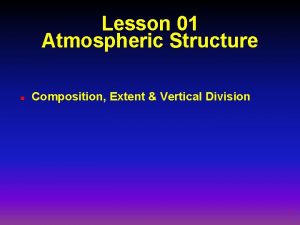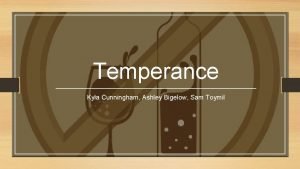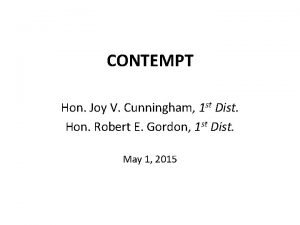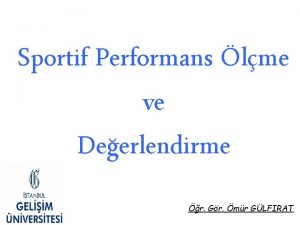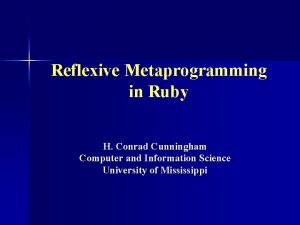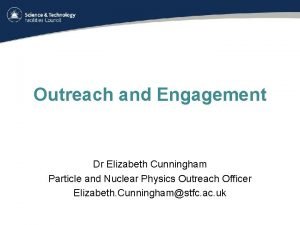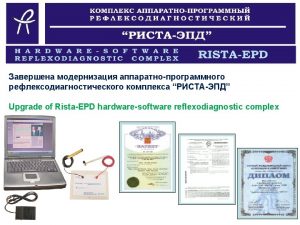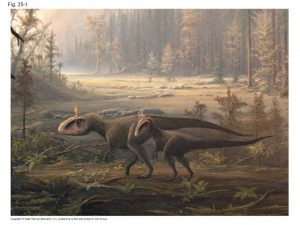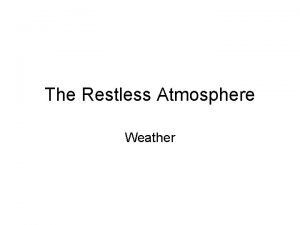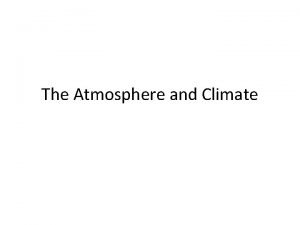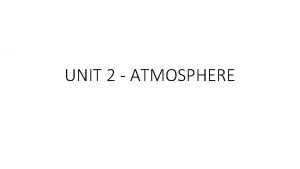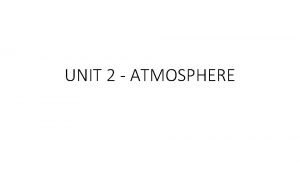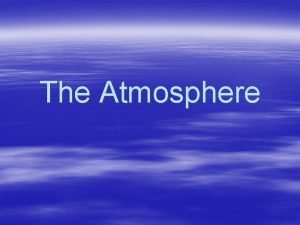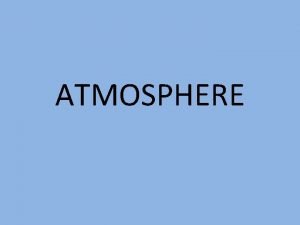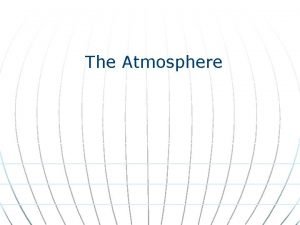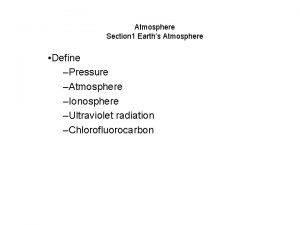Structure of Atmosphere From Cunningham Cunningham 2004 Fig


























- Slides: 26

Structure of Atmosphere From Cunningham & Cunningham, 2004, Fig. 9. 1

Wavelength and energy

What are the 3 ways heat can be transferred? • Radiation: transfer by electromagnetic waves. • Conduc tion: transfer by molecular collisions. • Convect ion: transfer by circulation of a fluid. Image from: http: //www. uwsp. edu/geo/faculty/ritter/geog 101/uwsp_lectures/ lecture_radiation_energy_concepts. html#Radiation

Sun - our star – the source of most of our energy For the entire earth, climate can be explained by: 1) the amount of sunlight received and 2) the character of the surface receiving it.

Energy Balance From Cunningham & Cunningham, 2004, Fig. 9. 2 Reflected = 25 + 5 = 30 Absorbed = 25 + 45 = 70

Sun’s energy is emitted in the form of electromagnetic radiation (Radiant Energy) • Radiant energy can interact with matter in 3 ways. • Most often its behavior is a combination of two or more of these modes • Reflection - there is no change in the matter because of the radiant energy that strikes it and it does not let the energy pass through it (i. e. it is opaque to the radiant energy), then it reflects the energy. Reflection only changes the direction of the beam of radiant energy, not its wavelength or amplitude. • Transparent - matter allows radiant energy to pass through it unchanged. Again, there is no change in any of the properties of the radiant energy. • Absorption –energy is transferred from the radiant beam to the matter resulting in an increase in molecular energy of the matter, later released as infared radiation

Reflectivity = Albedo • Reflected Energy/ Incident Energy • Higher reflectivity = brighter, shinier surface (snow, ice) • Lower reflectivity = darker, rougher surface (soil, sand) • Water – depends on the angle of the sun • Average albedo for Earth = 30 • Average albedo for moon = 7 Image from: http: //www. fourmilab. ch/earthview/vplanet. html

Energy Balance Incoming = 45 +88 = 133 Outgoing = 104 + 24 + 5 = 133 From Cunningham & Cunningham, 2004, Fig. 9. 2

Latent heat of fusion & vaporization Heat energy released 540 cal/gm 80 cal/gm

How much heat is released ? • • • Text book calculation 1 inch (= 2. 54 cm) of rain 1 km square area 580 cal/cm 3 (540 + 40 deg. ) 2. 54 cm/ 1 in * 100, 000 cm/ km * 100, 000 cm/km * 580 cal/ cm 3 = 17. 2 x 1011 calories

Greenhouse Effect Hot Earth - Cartoon

Radiation - and wavelength • Energy may be transferred from one object to another without the space between them being heated. (This is the mechanism where earth receives energy from the sun as radiation. ) • Waves of radiation can be distinguished by wavelength, which is the distance between two successive crests of the wave.

Wavelength and energy

Radiation - and wavelength. This is the Key to the Greenhouse Effect • The solar radiation reaching earth is in three wavelength spectra. • The sun emits 41% of its radiation in the visible spectrum, • 9% in the ultraviolet spectrum (short wave), and • 50% in the infrared spectrum (long wave). Image from: http: //www. uwsp. edu/geo/faculty/ritter/geog 101/uwsp_lectures/lecture_radiation_energy_concepts. html#Radiation

Radiation Laws - Black Body Radiation • Several physical laws describe the properties of electromagnetic radiation that is emitted by a perfect radiator, a so-called black body. • By definition, at a given temperature, a black body absorbs all radiation incident on it at every wavelength and emits all radiation at every wavelength at the maximum rate possible for a given temperature; • No radiation is reflected. • A blackbody is therefore a perfect absorber and a perfect emitter.

Radiation Laws - Black Body Radiation • The term black body can be misleading because the concept does not refer to color. • Objects that do not appear black may none the less be be blackbodies, perfect radiators. • Most gases are not blackbodies • Both the Sun and the Earth closely approximate perfect radiators, so that we can apply blackbody radiation laws to them. • We'll discuss 2, • ) Wien's displacement law and the • 2) Stefan-Boltzmann law.

Radiation Laws - Wien's Displacement Law • Although all known objects emit all forms of electromagnetic radiation, the wavelength of most intense radiation is inversely proportional to the T. ( 1/T) • Implications: • Sun emits @ ~ 6000 deg Kelvin • Earth emits @ 278 deg Kelvin, • Which will emit radiation at the longer wavelength? • Earth • The peak of Solar output is in the visible (light, shorter) part of the electromagnetic spectrum while the Earth, emits most of its energy in the infrared (heat, longer) portion of the electromagnetic spectrum

Radiation Laws - Wien's displacement law • What does this mean in terms of the Earth and the Sun? • Warm objects, Sun (6000°K) emit peak radiation at relatively short wavelengths (0. 5 micrometers ( 1 millionth of a meter) = yellow-green visible) • Colder objects Earth-atmosphere (average T of 278 °K, 15°C, 59°F) emit peak radiation at longer wavelengths ( 10 microns – infrared part of the spectrum) • Most of the sun's energy is emitted in a spectrum from 0. 15 µm to 4 µm. 41% of it is visible, 9% is uv, 50 % infra-red. • Earths radiant energy, stretches from 4 m to 100µm, with maximum energy falling at about 10. 1 µm (infrared).

Radiation Laws - Stefan-Boltzmann law • Would you expect the same amount of electromagnetic radiation to be emitted by the Earth and Sun? • No. The total energy radiated by an object is proportional to the fourth power of it's absolute T • F = k (T 4) = Stefan-Boltzmann law. • F (rate of energy emitted) • k = Stefan-Boatman constant ( 5. 67 x 10 -8 Wm-2 K-4) • Sun radiates at a much higher temperature than Earth. • Sun’s energy output/m 2 = 160, 000 that of Earth

Comparison -Earth & Sun Radiation • Sun – more energy & shorter wavelength • Earth-lower energy and longer wavelength

Atmospheric Composition % by Volume Major Constituents Nitrogen Oxygen 78. 1 20. 9 Active Minor Constituents Water vapor (H 2 O) Carbon Dioxide (CO 2) Methane (CH 4) Nitrous oxide (NO 2) Ozone (O 3) CFC’s H 2 O (liq & ice) variable (0. 48 aver. ) 0. 035 0. 00014 0. 00005 0. 000007 0. 00000014 0. 00000002 Inactive Minor Constituents Argon Neon Helium Krypton Xenon 0. 93 0. 0018 0. 00052 0. 0001 0. 000009

Greenhouse Gases – Why are they a problem?

What are some of the Greenhouse Gases? • Water Vapor • Molecular Ozone Antrhopogenic increases of these: • CO 2 • Methane • Nitrous Oxide • CFCs • Know the contribution of gases marked in green, to the greenhouse effect, where they come from, rates of increase

Mauna Loa Observatory CO 2 Measurements • 50 -60% of greenhouse effect • ~0. 5% increase /year • CO 2 in atmosphere today ~370 ppm • Estimated pre-industrial concentration -= 288 ppm • Highest past level that we can measure in ice cores, ~125, 000 years ago (280300 ppm!)

Greenhouse Effect Hot Earth - Cartoon

Heat Budget Extra version of Energy Balance Heat Budget
 Fig.2
Fig.2 Temperature change with height
Temperature change with height Vertical structure of the earth
Vertical structure of the earth Structure of atmosphere diagram
Structure of atmosphere diagram Explain composition and structure of atmosphere
Explain composition and structure of atmosphere Structure of atmosphere
Structure of atmosphere Atmosphere layers definition
Atmosphere layers definition Soft taffeta-like sounds
Soft taffeta-like sounds Frances cunningham finch
Frances cunningham finch Kocher yöntemi
Kocher yöntemi Claude cunningham
Claude cunningham Conrad cunningham
Conrad cunningham Dr sarah cunningham
Dr sarah cunningham Definition of curriculum by cunningham
Definition of curriculum by cunningham Robert abrams breanna cunningham
Robert abrams breanna cunningham Chapter 2-3 to kill a mockingbird
Chapter 2-3 to kill a mockingbird Ashley bigelow
Ashley bigelow Joy cunningham
Joy cunningham Statistics sample rates conor cunningham
Statistics sample rates conor cunningham Ted cunningham marriage
Ted cunningham marriage Rockport testi
Rockport testi Conrad cunningham
Conrad cunningham Dr elizabeth cunningham
Dr elizabeth cunningham To kill a mockingbird questions by chapter
To kill a mockingbird questions by chapter Audel cunningham
Audel cunningham Cunningham
Cunningham Cecilia cunningham
Cecilia cunningham

